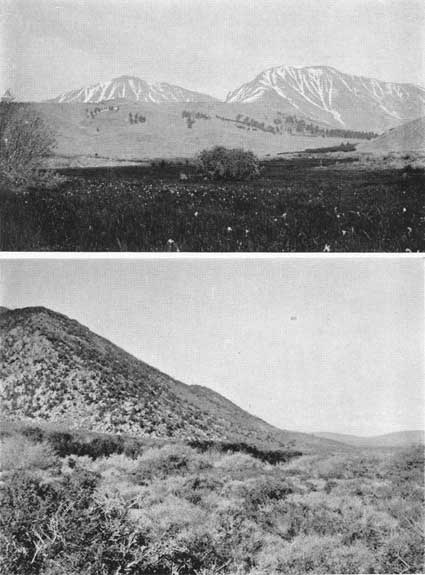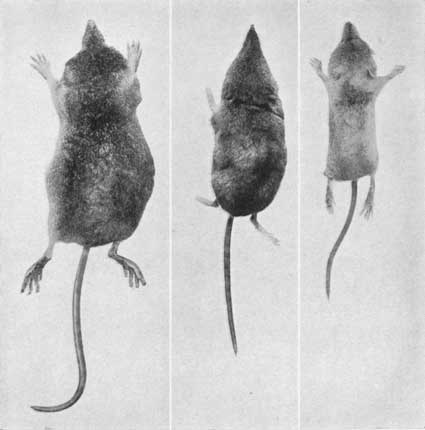|
PLATES
| UNIVERSITY OF CALIFORNIA |
[GRINNELL-STORER] PLATE 17 |

|
a. Ridge directly east of Half
Dome; altitude 7500 feet, in the Canadian Zone. The trees are chiefly
Jeffrey pine and in them are to be found the Sierra Grouse, Audubon
Warbler, Short-tailed Mountain Chickadee, Sierra Creeper and
Red-breasted Nuthatch. The low brush is huckleberry oak and this affords
shelter to the Allen Chipmunk and Mountain Alligator Lizard. Photo by
Ansel F. Hall (left).
b. Forest association in Canadian Zone one mile east of
Chinquapin; altitude 7000 feet. The trees are lodgepole pine, white fir,
and red fir. Birds noted here were Calliope Hummingbird, Hammond
Flycatcher, Blue-fronted Jay, Cassia Purple Finch, Pine Siskin, Audubon
Warbler, Short-tailed Mountain Chickadee, Red-breasted Nuthatch, and
Golden-crowned and Ruby-crowned kinglets. Mammals included the Tahoe
Chipmunk, Sierra Flying Squirrel and Sierra Chiekaree (right).
|
| UNIVERSITY OF CALIFORNIA |
[GRINNELL-STORER] PLATE 18 |

|
a. Vogelsang Lake (altitude
10,300 feet) and Pass (10,700 feet), Hudsonian Zone; photographed August
31, 1915. Rock talus at left and beyond, inhabited by Sierra Pine
Marten, Alpine Chipmunk, Gray Bushy-tailed Wood Rat, and Yosemite Cony;
meadow inhabited by Yosemite Meadow-Mouse; willow thicket frequented by
Hudsonian White-crowned Sparrow. Stunted white-bark pines on distant
slopes (top).
b. Looking eastward across Tuolumne Meadows; photographed July
13, 1915. Meadows and forest are in Hudsonian Zone, distant bare ridges
in Alpine-Arctic Zone; forest chiefly lodgepole pine. On the meadows
were recorded the Yosemite Meadow Mouse, Southern Sierra Marmot, Belding
Ground Squirrel, Pacific Nighthawk, Spotted Sandpiper, Killdeer,
Hudsonian White-crowned Sparrow, and Mountain Bluebird; at the forest
margin were the Mountain Weasel, California Badger, Golden-mantled
Ground Squirrel, Southern Sierra Marmot, Alpine Chipmunk, Sierra
White-tailed Jack Rabbit, and Western Chipping Sparrow; in the main
forest were the Tahoe Chipmunk, Sierra Chickaree, Yellow-haired
Porcupine, Arctic Three-toed Woodpecker, and Sierra Hermit Thrush
(bottom) (bottom).
|
| UNIVERSITY OF CALIFORNIA |
[GRINNELL-STORER] PLATE 19 |

|
a. Looking westward to Mounts
Dana and Gibbs from meadow at Farrington Ranch, southwest of Mono Lake;
photographed June 22, 1916. Meadow in foreground is in Transition Zone;
low hills beyond, interruptedly clothed with Jeffrey pine, are in
Canadian Zone; the forests, chiefly of lodgepole pine, on the slopes of
the peaks represent the Hudsonian Zone, and the upper bare portions of
the two mountains are in the Alpine-Arctic Zone. (This figure is
reversed, left to right; top.)
b. Side of Williams Butte facing northeast toward Mono Lake;
Transition Zone. Trees on the Butte are piñon pines, while in the
foreground are bushes of Kunzia and sagebrush, with a strip of
willows in the middle distance. Some birds characteristic of the
piño covered hill in September were Black-billed Magpie,
Woodhouse Jay, Piñon Jay, and Short-tailed Mountain Chickadee,
while in the sagebrush were Nevada Sage Sparrow, Brewer Sparrow,
Green-tailed Towhee, and Sage Thrasher. (bottom)
For discussion of the life zones in this vicinity, see text, pp.
8-10.
|
| UNIVERSITY OF CALIFORNIA |
[GRINNELL-STORER] PLATE 20 |

|
Common Shrews of the Yosemite region;
6/7 natural size. (left to right)
a. Navigator Shrew, east fork of Indian Cañon, June 23, 1915.
b. Yosemite Shrew, Yosemite Valley, December 29, 1914.
c. Dusky Shrew, same data as a.
The slender nose, inconspicuous eyes and ears, and plush-like pelage all
indicate relationship with the moles. The expanded, fringed hind toes
of the Navigator Shrew show correlation with its aquatic habits. For
discussion of species, see text, pp. 47, 50.
|
|
